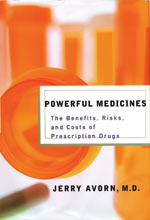|
|
 |
 |
 |
 |
|
BOOKSHELF Up Against the Drug Wall
|
||||||||||||||||||||||||||||||||||||||||||||||||||||||||
|
|

|
| Dr. Jerry Avorn ’69 PHOTO: JEFFREY THIEBAUTH |
Prescription drugs increasingly are in the headlines, with recent recalls of high-profile drugs, rising medicine costs and ongoing political battles over Medicare. Dr. Jerry Avorn ’69 provides a comprehensive overview of these issues and more in his book Powerful Medicines: The Benefits, Risks, and Costs of Prescription Drugs (Alfred A. Knopf, $27.50). Drawing on case studies taken from his experiences, Avorn traces the development of several major drugs and provides an understanding of how medical science and market forces shape the process.
Avorn had wanted to be a doctor since he was 8 and was certain he would become a primary care physician or family practitioner. As a Harvard Medical School student, however, he became interested in prescriptions drugs and how little we know about them.
While in training, Avorn realized that drug companies, which spend millions annually on marketing, were effective at changing doctors’ beliefs and behavior, but only to push products. He felt that medical school faculty had less biased information to offer on prescription drugs but were not as effective in communicating with doctors. In 1979, Avorn began writing his first grant proposal to develop what is known as “academic detailing,” a combination of the evidence-based approach of academics with the effective communication methods of drug company sales representatives, known as detailing. Avorn reported the first successful results in The New England Journal of Medicine in 1983, and the process has since been adopted worldwide.
|
|
 |
Powerful Medicines:
The Benefits, Risks, and Costs of Prescription Drugs by
Dr. Jerry Avorn ’69 |
“The central idea of Powerful Medicines,” explains Avorn, “is that every drug is a triangle with three faces, representing the healing it can bring, the hazards it can inflict and the economic impact of each.” The book addresses the three faces in five sections: Benefits, Risks, Costs, Information, and Policy. Avorn also exposes how big drug companies fail to release enough information and criticizes the limitations of the FDA’s drug approval process, which allows companies to omit unfavorable clinical trial data. He proposes a new kind of “information-transfer organization” that would provide doctors with easy access to unbiased information and enable them to prescribe drugs in a cost-effective way.
Avorn’s reform-minded approach, while critical of drug companies and their profit-driven behavior, is not a condemnation. He takes a broader approach by putting drug costs in the bigger picture of health resource allocation and points out the difficulty that doctors and patients face trying to find unbiased information. Efforts are being made to push for a national registry that would allow doctors to see more comprehensive clinical trial results of prescription drugs they are thinking about prescribing. Avorn believes that a registry will not be the ultimate solution, but thinks that it is a good start. For the general public looking for unbiased information about prescription drugs, Avorn suggests “The Medical Letter” (www.medletter.com) or the “Best Buy Drugs” program from Consumer Reports (www.consumerreportshealth.org).
Avorn is professor of medicine at Harvard Medical School and chief of the division of pharmacoepidemiology and pharmacoeconomics at Brigham and Women’s Hospital. Pharmacoepidemiology is the study of the way doctors prescribe medicine and how patients use drugs, and pharmacoeconomics is a comparative study of the costs and benefits of similar drugs. Avorn designs studies to learn more about drug effects and how to improve medication use by doctors and patients. He also teaches medical students, interns and residents about proper prescribing practices.
Powerful Medicines is Avorn’s second book. In summer 1968, after the tumultuous events at Columbia that spring, Avorn teamed up with fellow Spectator editors to write Up Against the Ivy Wall: A History of the Columbia Crisis (Antheneum, 1968), “a sincere attempt by Columbia students to make a statement about the Vietnam War, and about the way the University administration was treating students and the surrounding community.” The book covered the student movement on campus from 1966–68 and was written to debunk media accounts that claimed the movement was inspired by outside agitators.
Whether it is a critical look at the 1960s or the way drug companies inflate prescription drug prices, Avorn credits the Core Curriculum, especially Contemporary Civilization, for giving him an understanding of “how important it is to look at a problem through the lenses of different disciplines. [The Core] also gave me the confidence to analyze questions from the perspective of fields other than my own, which I guess you could call wisdom, or hubris, or chutzpah,” Avorn says.
The Core may also have contributed to Avorn’s decision to grow a beard during medical school. “I grew [it] when I realized it was weird to scrape a sharp piece of metal across your face every morning to match some arbitrary definition of being civilized,” he says. He has kept it since. When not working or teaching, Avorn likes to garden and debate politics with his son, Andrew ’08. “He’s a little more conservative than I am, but he’s coming around.”
Peter Kang ’05
| || | || |
CCT Home |
|
|
CCT Masthead |